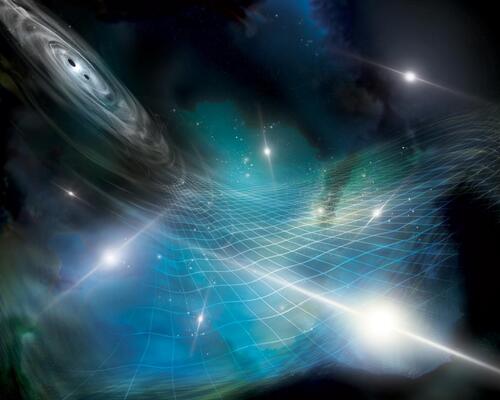
In the last few years there has been growing interest in low-frequency gravitational waves. On June 29, 2023, after 15 years of searching, the North American Nanohertz Observatory for Gravitational Waves (NANOGrav) collaboration and its international partners announced evidence for the detection of a gravitational wave background–the first time any gravitational wave background has been found with any detector. Before this point, only high-frequency gravitational waves had been detected.
Chiara Mingarelli, assistant professor in physics, said, “What we found is evidence of hundreds of thousands of simultaneously merging pairs of supermassive black holes, with gravitational wavelengths of light-years… There has been much excitement in the broader astrophysics community surrounding it.”
While there have been several special sessions dedicated to NANOGrav results at the American Astronomical Society (AAS) and American Physical Society (APS) meetings, there had not been a dedicated workshop or symposium where members of the community could ask questions about the results and future prospects.
To address this need, the first Yale Gravitational Wave Symposium was held from November 20-21, 2023 at Yale University’s Kline Tower in New Haven. This symposium provided the gravitational wave research commmunity the opportunity to engage with key NANOGrav members and to delve into the latest advancements in the field by fostering in-depth discussions regarding NANOGrav’s recent suite of papers, exchanging insights, and discussing the course for future directions for research in the field.
Mingarelli, who led the symposium organizing committee, said, “My biggest hope for the symposium was to bring together experts in NANOGrav together with the broader community in physics and astronomy to discuss the current results, and to imagine future ways to collaborate. The field of multimessenger astrophysics – the measurement of e.g., light and gravity from the same physical system – is still very young. The detection of low-frequency gravitational waves is inherently multimessenger, combining expertise in radio astronomy, extra-galactic astronomy, data analysis, and fundamental physics. I believe it is important to have as much communication between astronomers, astrophysicists, and experts in data analysis to move the field forward, and to pursue new avenues of research together.”
The symposium brought together a mix of experts from complementary cutting-edge experiments such as the Event Horizon Telescope, LIGO, Vera Rubin LSST; experts in industry from Wolfram and the Flatiron Institute; and colleagues from top universities and research centers across the United States and Europe working in cosmology, astrophysics, data analysis, and other fields of gravitational waves.
Meg Urry, the Israel Munson Professor of Physics and one of the members of the scientific organizing committee, commented, “The force behind the meeting was Chiara Mingarelli, but I will say that it involved a wonderful mix of gravitational wave signal-processing experts and astrophysics-oriented people. The gap was just wide enough that both groups learned a lot, and just narrow enough that we could understand one another.”
In addition to Mingarelli and Urry, other members of the scientific organizing committee included Priyamvada Natarajan, Joseph S. and Sophia S. Fruton Professor of Astronomy and Professor of Physics; Scott Ransom, staff astronomer at the National Radio Astronomy Observatory (NRAO); and Tristan Smith, associate professor of physics at Swarthmore.
The meeting format was designed to foster discussions. There were 4 sessions over 2 days. The first day of the symposium focused on the gravitational wave background and pulsar noise, while the second day focused on both astrophysical interpretations of the background and new physics. Each session had a short plenary talk, followed by 3 “deep dive” talks; and the rest of the time was devoted to discussion.
Mingarelli explained that this format gave the community the opportunity to ask clarifying questions about the NANOGrav experiment, and foster conversations and debates about open questions in fundamental physics.
Urry added that “the meeting space on the 14th floor was fabulous, as it allowed everyone to stay together from talks to meals and back again, thus helping build the community feeling and encouraging many more conversations than would have been possible had we all gone out to forage for meals”.
As a result of the symposium, Mingarelli said, “I personally came up with 5 new paper ideas with colleagues during the meeting – it was very productive!”
See below links for further information on the NANOGrav Collaboration and for photos, taken by Geriana Van Atta during the event.